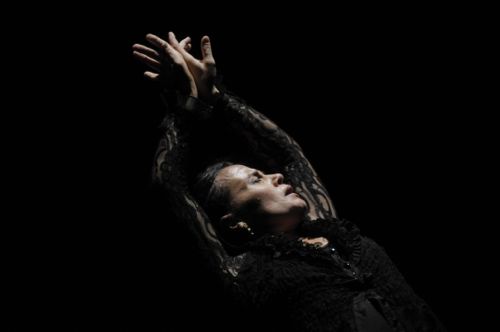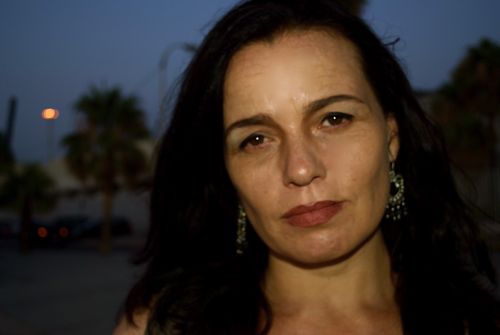Soledad Barrio, one of the greatest dancers of our time, in any genre—hers is flamenco—is giving class. The venue is a modest studio over a ground-floor church on West 86th Street. The dancing arena must boast a very resilient floor in addition to its three chandeliers, the only hint of “décor” in sight.
 Soledad Barrio, onstage
Soledad Barrio, onstage
Instead of one of the long, gaudy ruffled gowns Barrio wears for her existence onstage—which has ignited the imagination of admirers worldwide—she wears a black t-shirt and black trousers flared at the ankles. Her hips are swaddled in a white scarf strewn with bold black ovals that conjure up the notion of paw-prints. Her feet are shod in the classic gear of women practicing her trade—black round-toe pumps with sturdy Cuban heels that have an alternative identity as weapons, now striking or slashing at the floor or delivering urgent whispered messages to it. Her dark hair is yanked back in a braid that becomes more and more wispy as the lesson proceeds. She wears no makeup, not a speck.
Tirelessly, she demonstrates, full-out, over and over again, what she wants from her eight pupils—a motley crew of varying degrees of experience. The quality they have most clearly in common is an unspoken yet evident belief—you can see it in their worshipful gaze—that her knowledge of flamenco is unsurpassed.
Although she may laugh and joke occasionally with her students, she’s subtly merciless when it comes to clarity and correctness. She believes, passionately, that exactitude is essential; clearly she’s a model of that herself. I’d never realized how important it was in her theatrical performances.
When she demonstrates the phrases she’s asking her pupils to reproduce, she seems to be dancing full out, but if you’ve seen her onstage you know that here she’s just marking. In performance Barrio invariably goes far beyond what one pre-conceived as the limit.
Her English is good enough to convey the basics, and, teaching in New York, she naturally uses the local lingo. Needless to say, however, there are enchanting linguistic gaps. To be sure, her regular students understand her better than I could because she’s familiar to them. Like many a dance teacher, she’s a very funny mimic, but her physical imitations of her students’ flawed execution are inevitably far from kind. Not one of the women looks like even a possible Barrio protégée. Why, I wonder, does Barrio lack the caliber of students she deserves?
I adored the few minutes in which she demonstrated “spotting”—the same sort of “trick” ballet dancers use to avert dizziness when executing multiple pirouettes and the cousins thereof. It was enough to make a small child believe the lady was a witch.
I was thrilled by the sight and sound of her the feet hitting the floor faster and faster, a bedazzling form of percussion.
As the pupils are executing a complicated sequence, she says mildly—perhaps a little ironically—“Feel the floor.” Explaining a move that swirls back on itself, she proposes this: “In the last moment, to say yes, you say no.” This is the only instruction she gives in this session that is not solely technical.
Her demonstrations of many a long chain of movements often make you think of eating—of devouring, actually. At other moments she holds her head, jutting into space, like that of a lethal snake injecting its poison into a victim. But she never refers to “meaning” in her instructions, only to movement—the element, as Martha Graham so often reminded us, that never lies.
She stretches an arm out to the side and undulates it, as if whipping up a generous bowl of cream or egg whites, first to a froth, then to firm mountain peaks. Still, there’s no addition of drama.
On a 12-count phrase, she tries to get her students to do nothing on one of the counts. Doing nothing proves to be difficult, a challenge. This is a common problem among dancers, especially the younger ones, no matter what their genre. Only mature, gifted, or “born” dancers have stillness in full command.
 Barrio, offstage
Barrio, offstage
Photo: Gabriela Goldin Garcia
In a class that lasts a good deal longer than the 90 minutes scheduled for it, Barrio never once mentions, or even refers to obliquely, the emotional, psychological, or theatrical aspects of her work—the areas that make her world-famous. I suspect she chooses not to. Perhaps she feels that these elements belong to her alone. Perhaps she’s willing to share her technique but not her artistry, which, for all I know, she considers her identity. Most likely, she’s learned, no doubt the hard way, that some things cannot be taught.
Barrio will be appearing in New York with her company, Noche Flamenca, at Joe’s Pub, January 3-8 (two shows daily except on closing night).
© 2013 Tobi Tobias



